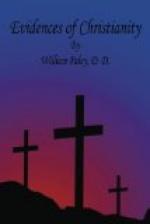This particular design may appear sometimes, but not always, nor often. Thus I think that the particular design which Saint Matthew had in view whilst he was writing the history of the resurrection was to attest the faithful performance of Christ’s promise to his disciples to go before them into Galilee; because he alone, except Mark, who seems to have taken it from him, has recorded this promise, and he alone has confined his narrative to that single appearance to the disciples which fulfilled it. It was the preconcerted, the great and most public manifestation of our Lord’s person. It was the thing which dwelt upon Saint Matthew’s mind, and he adapted his narrative to it. But, that there is nothing in Saint Matthew’s language which negatives other appearances, or which imports that this his appearance to his disciples in Galilee, in pursuance of his promise, was his first or only appearance, is made pretty evident by Saint Mark’s Gospel, which uses the same terms concerning the appearance in Galilee as Saint Matthew uses, yet itself records two other appearances prior to this: “Go your way, tell his disciples and Peter, that he goeth before you into Galilee: there shall ye see him as he said unto you” (xvi. 7). We might be apt to infer from these words, that this was the first time they were to see him; at least, we might infer it, with as much reason as we draw the inference from the same words in Matthew: the historian himself did not perceive that he was leading his readers to any such conclusion; for, in the twelfth and following verses of this chapter, he informs us of two appearances, which, by comparing the order of events, are shown to have been prior to the appearance in Galilee. “He appeared in another form unto two of them, as they walked, and went into the country; and they went and told it unto the residue, neither believed they them: afterwards he appeared unto the eleven, as they sat at meat, and upbraided them with their unbelief, because they believed not them that had seen him after he was risen.”
Probably the same observation, concerning the particular design which guided the historian, may be of use in comparing many other passages of the Gospels.
CHAPTER II.
Erroneous opinions imputed to the apostles.
A species of candour which is shown towards every other book is sometimes refused to the Scriptures: and that is, the placing of a distinction between judgment and testimony. We do not usually question the credit of a writer, by reason of an opinion he may have delivered upon subjects unconnected with his evidence: and even upon subjects connected with his account, or mixed with it in the same discourse or writing, we naturally separate facts from opinions, testimony from observation, narrative from argument.




